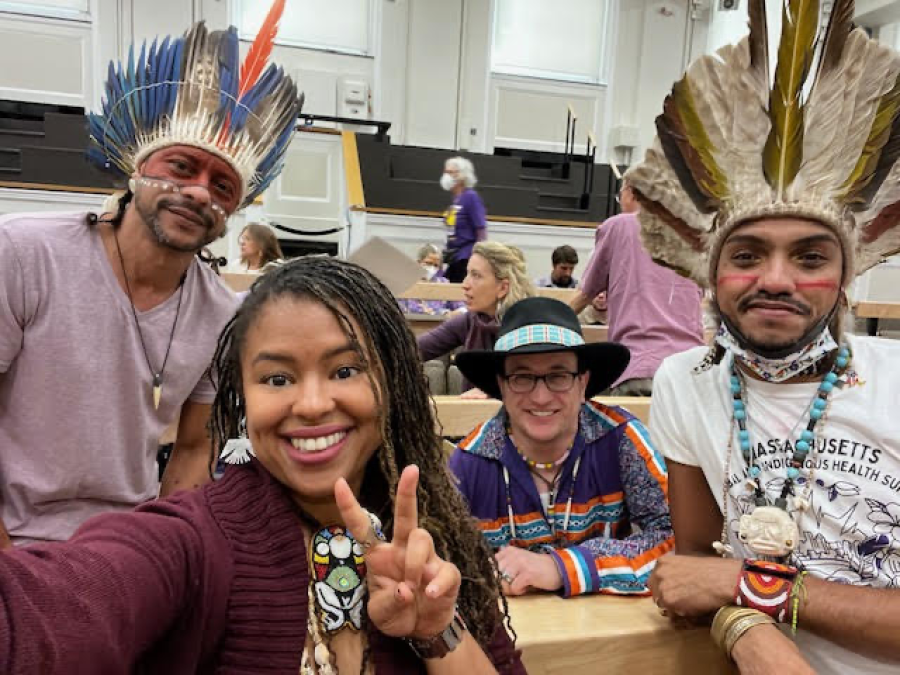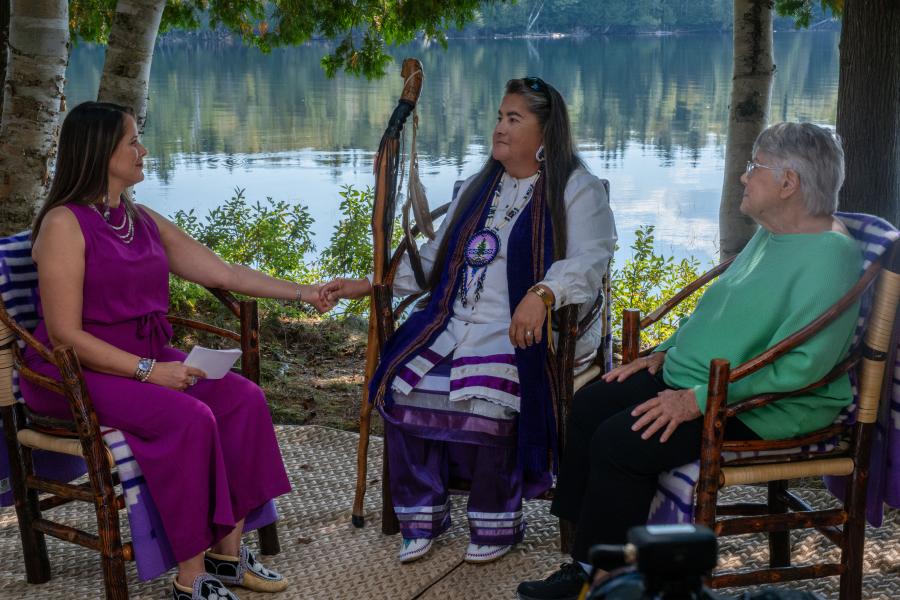Access to credit has consistently been identified as one of the key elements necessary to increase economic capital and stimulate economic development, on or off Indian reservations. World Bank economists claim that the problem of gaining access to credit is an important determinant in low-income areas' participation in the economic growth of a country. (Binswanger & Deininger, 1997; Mushinski, 1999) Indigenous communities often lack the collateral necessary to secure bank loans. They also commonly lack social or personal ties with bankers or investors. Financial institutions are typically associated with the settler communities that historically appropriated indigenous lands and resources. Indigenous poverty is also perpetuated by institutions at the local level that are controlled by the descendents of colonists and settlers and reflect historically constructed class, race, and culture divides. (Ward, 1998) Alternative, indigenous-controlled institutions are needed to provide both economic capital and social linkages for historically excluded communities.
The Reservation Context
The Pine Ridge Indian Reservation, established in 1889, is home to the Oglala Sioux Tribe. Located in a remote region of southwestern South Dakota, the Reservation is as big as the state of Connecticut and has a population of 11,000 to 35,000 residents.(1)
The Reservation presents a special challenge to economic development because development depends on effective access to and investment of several forms of capital, including financial capital, human capital, and social capital. The Reservation encompasses the county with the highest level of poverty in the last two United States Decennial Censuses. (Pickering, 2000) Low-income households do not have sufficient assets for collateral or sufficient assets to finance business projects.
High poverty rates also tend to be associated with low levels of education, which undercut the critical element of human capital needed for business development -- the value found in people's knowledge and skills. In the 1990 Census, 55.8 percent of American Indians from the Pine Ridge Reservation had high school diplomas or higher, and 32.3 percent had some college or higher. In the U.S. population, 75 percent had high school diplomas or higher, and 45 percent had some college or higher.
Unemployment and underemployment are major concerns on the Reservation. Those with higher household and per capita incomes tend to be people with full-time employment, especially tribal or federal government jobs. Unemployment rates for the Reservation are deplorable. In 1999, the Bureau of Indian Affairs (BIA) reported 73 percent unemployment on the Reservation, although some speculate that unemployment is even higher. Since few people are able to locate full-time, year- round positions, they must piece together short-term or parttime jobs, making underemployment common. (Pickering, 2000) As a result, interest in starting small businesses to create jobs for unused and underutilized local people is growing.
Formal Banking Institutions
There is no bank on the vast Pine Ridge Reservation; most residents must travel to towns bordering the Reservation -- between 40 and 180 miles round trip -- to take care of their banking needs. Lakota access to formal credit is dependent on institutions controlled by non-Indians in Reservation border towns. Yet these towns have a long history of racial tension and hostility toward Indians. Many Reservation residents feel oppressed by racial and cultural discrimination in border town banks. Said one Lakota businessman,"...the bank wouldn't give me a loan because I'm an Indian." Without local banking relationships, individual access to formal credit for economic development on the Reservation is severely limited. Some consumer loans are available when items purchased with them -- such as cars or trailers -- can serve as collateral, or when regularly deposited checks are used to secure small cash advances. But given Reservation poverty and the history of federal government housing programs dominating the housing market, potential Lakota commercial borrowers are less likely to have significant assets -- like mortgages and privately owned houses -- with which to secure loans with traditional banking institutions.
To the extent that credit is available, it is significantly easier to obtain for consumption purposes than for business purposes. (Pickering & Mushinski, 2001) And when capital is accessed for consumption loans it is removed from the Reservation to border town stores and enterprises and does not generate additional income and jobs within the Reservation. Lakota business people often express frustration with the limited level of communication they are able to establish with formal banks, even those they have accounts with. Small business owners running convenience stores, tourist operations, consulting businesses, or small scale agricultural enterprises consistently express the need for additional credit.
The Lakota Fund
To offset these barriers, the Lakota Fund was established in 1986 as a project of the First Nations Financial Project. A Lakota-controlled financial institution in the village of Kyle on the Reservation, it was established with an initial loan fund of $400,000 from the Ford Foundation. Its purpose was to make loans available for Lakota micro-entrepreneurs and small business people. The Lakota Fund has provided varying levels of credit through several different programs over the years. (Mushinski & Pickering, 1996; Pickering & Mushinski, 2001) Circle Banking was a form of peer group lending that provided loans of between $100 and $1000 to individuals willing to accept the obligation to repay loans for other members of their circle. The Lakota Fund is currently providing this same range of small loans to individuals with standard or alternative forms of collateral, like headwork or family heirlooms. It has also provided individual loans of between $1,000 and $25,000 for small businesses with collateral. The Fund requires that a series of training courses be attended before any individual is eligible for a loan. The training curriculum, entitled "Tokatakiya Iciskanpo: Prepare for the Future," includes sessions on nation-building and capital, personal goals and skills, marketing, budgeting, bookkeeping, financial statements, human resources, and family dynamics.
Benefits of Local Institutions
In contrast to border town banks, the Lakota Fund, an indigenous Plan B (see Downing and Downing-Garcia, this issue), is a community development financial institution functioning inside the social capital networks of the Reservation. It is able to use local information unavailable to or unsolicited by banks. Through better access to information about local residents and lower costs of monitoring its local borrowers, the Lakota Fund is able to reduce some of the problems associated with off-Reservation banks. It could use local knowledge of applicants, for example, to extend credit to business people who had isolated and unrepresentative problems with their credit history. As one small business participant explained:
I couldn't get a bank loan because of bankruptcy over our ranch, and that was because the bankers lied across the table. At the Lakota Fund, they're willing to help out and to sit down and listen to you, and not be afraid. Just because we had to file bankruptcy on the ranch, that didn't shut my business career off Indian people can go and get a loan without feeling that they are discriminated against. At Lakota Fund, they understand; they know our way of life.
As a result, residents consider the Lakota Fund to be the only source of business credit on the Reservation. To date, the Fund has offered technical assistance to 2,525 individuals and provided $1.9 million in loans. Among micro-enterprise loans, approximately 80 percent of the borrowers have been women, and approximately 30 percent of the larger business loans have been extended to women. The Lakota Fund currently has a 10 percent default rate across all loan programs. It was instrumental in getting a debt collection code enacted by the tribal council to improve the performance of the tribal court system in responding to commercial cases.
The Lakota Fund has been particularly effective in tailoring its assessment of collateral resources to the social, legal, and cultural context of the Reservation. Collateral requirements can have a notable impact on household access to credit in low-in- come areas. (Swaminathan, 1991) Such wealth-biased access to credit is even more insidious because it may restrict low-wealth households from participating in a country's economic development, producing unbalanced growth. (Binswanger & Deininger, 1997; Carter et al., 1994) Substantial numbers of both Lakota Fund microentrepreneurs and small business people reported having insufficient collateral to seek a bank loan for their business. (Pickering & Mushinski, 2001)
The Lakota Fund also has a better understanding of the unique legal conditions on the Reservation that create obstacles for Lakota business people attempting to marshal their assets for finance capital. The nature of land ownership for Reservation residents, for example, has a direct impact on access to credit. In general, land is a desirable form of collateral. (Swaminathan, 1991) Most Lakota landowners, however, own allotted land that is held in trust by the federal government, and may have an undivided interest in land held by multiple heirs. While banks are, in theory, willing to consider trust land as collateral for loans, the reality is that the bureaucratic delays and uncertainties associated with using trust land as collateral and with foreclosing on it make it an undesirable option. (Shepherd, 1997) In contrast to border town banks, the Lakota Fund is willing to consider trust land as collateral without requiring borrowers to go through the lengthy bureaucratic process of taking the land out of trust. It combines confidence in borrowers' ability to repay with knowledge of federal and tribal land policies and procedures should a default take place.
Also important to Reservation residents is the atmosphere at the Lakota Fund. As one resident noted, "They didn't look down on us like the banks did...." The discrimination and racial tension associated with border town banks were not mentioned by borrowers discussing the Lakota Fund. As one Lakota Fund participant recalled, "It was people you can talk to and they were more willing to help. You didn't feel threatened by going and talking to them about what you wanted to do. It was just easier because I'm Native American and some of the workers are too. It was easy to converse there rather than go to the local bank. I wouldn't even try going [to the bank] up here." Having Lakota Fund personnel who speak the Lakota language was mentioned as another advantage over banks.
The Lakota Fund's provision of training in preparation for obtaining a loan uses social capital to expand the community's human capital. In effect, the Lakota Fund is focusing on increasing human capital along with its injection into the local economy of financial capital. The recipients of small business loans from the Lakota Fund described many ways in which this type of advice is valuable in saving money and avoiding business pitfalls. Other participants discussed the hands-on technical assistance provided by the Lakota Fund.
Through its increasing participation in the social networks of Lakota businesses, the Lakota Fund is developing important organizational integrity. The Fund is providing coherence, competence, and capacity with which to supplement economic development on the Reservation.
It is able to bypass the border town banks and create macro-level synergies by tapping previously unused social relationships. Over the years, the Lakota Fund has attracted socially responsible investors for their lending capital from such major U.S. cities as Boston and San Francisco who are willing to accept up to a 3 percent return for an investment of at least one year.
Like other Plan Bs around the world, the Lakota Fund for Native Americans on the Pine Ridge Reservation has helped an indigenous people cope with the results of a long history of prejudice and surmount obstacles to economic and cultural survival.
References & further reading
Aoki, A. & Chatman, D. (1997, April). An Economic Development Policy for the Oglala Nation. Harvard Project on American Indian Economic Development.
Binswanger, H. & Deininger, L. (1997). Explaining Agricultural and Agrarian Policies in Developing Countries. Journal of Economic Literature XXXV:4, pp 1958-2005.
Carter, M., Barham, B., Boucher, S. & Zegarra, E. (1994). Closing the Financial Efficiency Gap: the Role and Design of Cooperative Financial Intermediaries in Low Income Countries. Unpublished: University of Wisconsin-Madison.
Drabenstott, M. (1999, Spring). Rethinking Rural America's Financial Markets. Forum for Applied Research and Public Policy 14:1, pp 96-100.
Mushinski, D. W. (1999). An Analysis of Offer Functions of Banks and Credit Unions in Guatemala. Journal of Development Studies 36.2, pp 87-111.
Mushinski D. W. & Pickering, K. (2001). Credit Access for Indian-Owned Small Businesses -- The Overlooked Need. Unpublished Manuscript.
Mushinski, D. W. & Pickering, K. (1996). Micro-enterprise Credit in Indian Country. Research in Human Capital and Development 10, pp 147-169.
Pickering, K. (2000). Lakota Culture, World Economy. Lincoln: University of Nebraska Press.
Pickering, K. & Mushinski, D. (2001). Cultural Aspects of Credit Institutions: Transplanting the Grameen Bank Credit Group Structure to the Pine Ridge Indian Reservation. Journal of Economic Issues 26, pp 2.
Shepherd, D. (1997, October). The Native American Housing Market. The Journal of Lending and Credit Risk Management 80:2, pp 36-39.
Swaminathan, M. (1991). Segmentation, Collateral Undervaluation, and the Rate of Interest in Agrarian Credit Markets: Some Evidence from Two Villages in South India. Cambridge Journal of Economics 146:2, pp 161-178.
Ward, C. (1998). The Importance of Context in Explaining Human Capital Formation and Labor Force Participation on American Indians in Rosebud County, Montana. Rural Sociology 63:3, pp 451-480.
(1). The current Reservation population count is uncertain, in large part because estimates are based on the results of the 1990 U.S. Census which seriously undercounted the population at 11,006 American Indian residents. The late 1990s saw an influx of people to the Reservation because of the imposition of welfare reform and the perception that regulations governing TANF (Temporary Assistance to Needy Families) are less stringent on the Reservation. The Oglala Sioux Tribe estimates the current population at 35,000.
Article copyright Cultural Survival, Inc.



